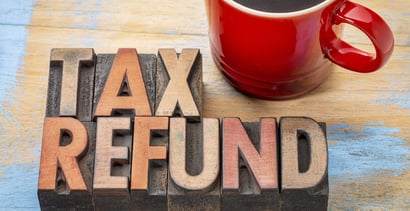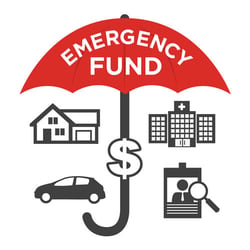

When it comes to tax season, there are two types of people — those who dread filing because they’re worried about what they owe and those who check their mailbox daily in anticipation of a refund check.
If you’re among the latter and expecting money back from the government, a sizable check could be coming your way. In fact, the average tax refund in 2019 was around $2,725.
While it’s easy to look at this refund as free money and start dreaming up all the different kinds of things you could buy, don’t let your imagination tease you. Remember, these are your hard-earned dollars being returned to you, and there are far better ways to spend this money.
If you’re wondering how you could put your tax refund to work to improve your financial situation and provide more stability for your family, check out these five tips.
1. Pay Down High-Interest Debt
If you’re carrying a balance on your credit card, consider paying down debt with all or part of your tax refund. With the average interest rate hovering around 19%, according to WalletHub’s Credit Card Landscape Report, it’s hard to make a dent in your debt if you’re only paying the minimum due each month.
And, as interest accrues, it’s possible this monthly payment is only covering the interest you’re racking up. With your refund check, you could quickly shrink the balance on your cards to a more manageable amount and save potentially hundreds of dollars in interest.
Not only does this mean you will save money, but you will also lower your credit utilization rate — something lenders use to calculate 30% of your FICO credit score — and give your credit score a boost. If your tax refund isn’t enough to wipe away your entire balance, look into a new credit card.
You could transfer the remaining balance to a new card that offers 0% interest on balance transfers for anywhere from 12 to 21 months, which will buy you more time to pay down the debt, interest-free. If you have a low credit score, however, you may not qualify for a 0% APR balance transfer offer.
Although it’s much more exciting to use your tax refund to purchase a new TV or handbag than it is to pay down debt, the future benefits of becoming debt-free can lead to a variety of guilt-free splurges, like a romantic dinner out with your partner or a relaxing massage. Just keep your eye on the prize!
2. Start (or Add to) Your Emergency Fund
An emergency fund is crucial to creating financial stability for you and your family. However, a recent survey found that only 40% of Americans would be able to cover an unexpected expense of $1,000.

Aim to have three to six months’ worth of living expenses set aside for emergencies.
That means a whopping 60% of consumers will find themselves in a bind if a series of unexpected bills pile up. Considering accidents that require medical attention and job loss are rather unpredictable, setting aside three to six months’ worth of living expenses in a separate account can give you peace of mind and plenty of cushion in your budget to get through a tough time.
And those who neglect to save could end up digging themselves deeper into debt when an emergency expense arises if they have to use a high-interest credit card to pay for it.
While building emergency savings may feel overwhelming when you begin calculating your essential monthly expenses, setting aside your tax refund or a portion of it is an easy way to give your emergency savings a quick boost.
3. Refinance Your Mortgage
Depending on your original mortgage rate, you stand to save hundreds of thousands of dollars on your mortgage loan and lower your monthly payment by refinancing. Homeowners often give up on refinancing once they find out how much money they must pay upfront in lender fees, but your tax refund can help cover those fees.
Before you call the first mortgage lender you can find to refinance, there are several things you must first consider. Always shop around for rates just as you would compare prices on a new TV — interest rates vary from lender to lender by as much as one percentage point, which can make a major difference in how much you ultimately save on interest.
It’s also important to read the fine print so you understand all the fees you will be responsible for paying, which may also vary between mortgage loan companies.
If refinancing isn’t an option right now, your tax refund could be used to make an extra mortgage payment. By doing this each year, you will substantially reduce the principal balance and shave months or years off your mortgage repayment time while also reducing how much you pay in interest over the life of the loan.
4. Invest in Yourself
When people think about investing, they usually think about retirement plans, the stock market, or real estate. However, the safest and most surefire investment shouldn’t be overlooked, and it’s one you see every day — yourself.

Leverage workshops, conferences, and educational resources to improve your skill set.
Considering your ability to make money is one of your greatest assets, using your refund to grow your knowledge and skills could boost your earning potential.
If you’re in debt, making more money is the ticket to finding more flexibility in your monthly budget to manage expenses and pay off credit card balances.
To get started investing in yourself, look for ways to improve or add to your current skill set. Attend workshops and conferences or sign up for continuing education courses at your local community college.
Networking events are a great place to connect with new business contacts that could lead to better paying job prospects or new clients. A mastermind group can help keep you accountable and motivate you to reach new levels of proficiency in your business. The options to invest in yourself are limitless!
5. Tackle Home Improvements
Spring is the perfect time to tackle those home improvement projects you’ve been putting off, which can ultimately increase the value of your home. This is especially helpful if you’re considering selling — not only will an updated space look more appealing to buyers, but it may just be enough to make you want to stay put.
Although the majority of your tax refund should go to more important financial priorities, such as paying down debt and boosting your savings account, you can use a small portion of your refund on an inexpensive DIY project that can make your space feel updated.
For instance, a fresh coat of paint throughout your home can brighten your space, and new pulls and handles on cabinets can make your kitchen look modern without spending a lot of money.
Advertiser Disclosure
BadCredit.org is a free online resource that offers valuable content and comparison services to users. To keep this resource 100% free for users, we receive advertising compensation from the financial products listed on this page. Along with key review factors, this compensation may impact how and where products appear on the page (including, for example, the order in which they appear). BadCredit.org does not include listings for all financial products.
Our Editorial Review Policy
Our site is committed to publishing independent, accurate content guided by strict editorial guidelines. Before articles and reviews are published on our site, they undergo a thorough review process performed by a team of independent editors and subject-matter experts to ensure the content’s accuracy, timeliness, and impartiality. Our editorial team is separate and independent of our site’s advertisers, and the opinions they express on our site are their own. To read more about our team members and their editorial backgrounds, please visit our site’s About page.


